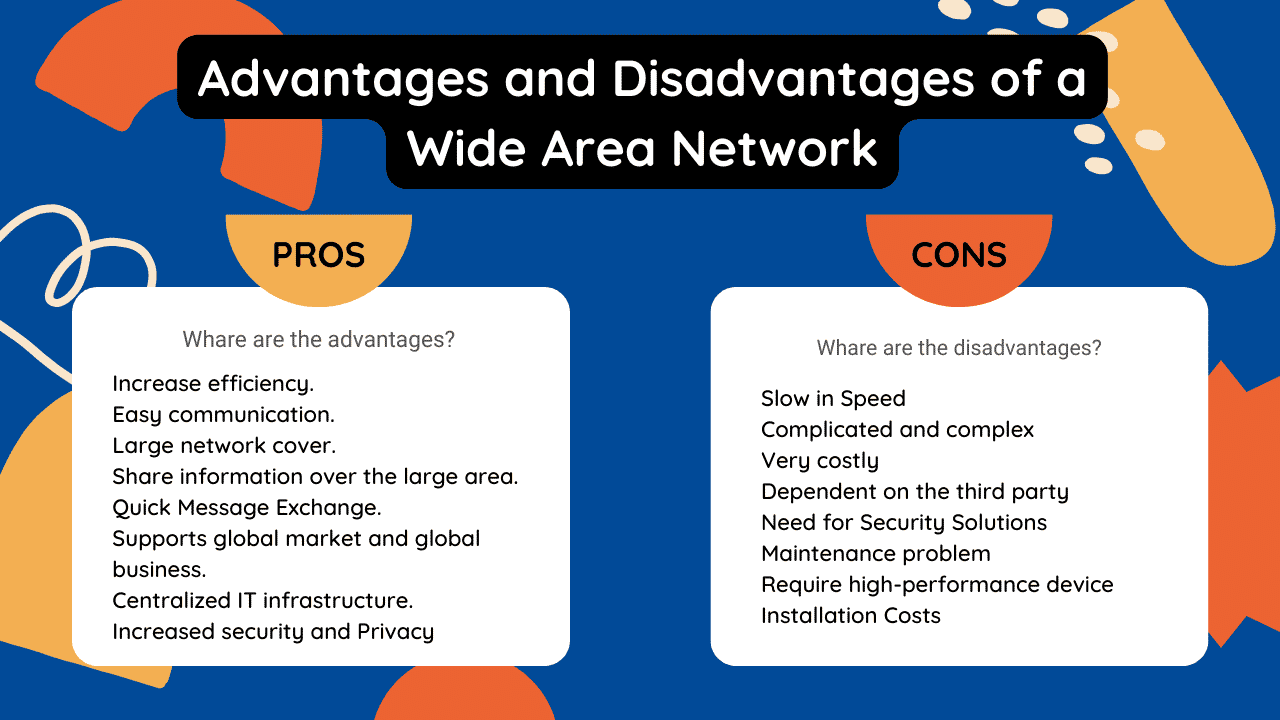When it comes to business, there are a lot of important decisions to make. One of the most critical decisions is deciding what type of network to use. A Wide Area Network, or WAN, is a network that connects multiple local area networks together. It allows businesses to share resources and information with each other quickly and easily. In this article, we will discuss the Advantages and Disadvantages of a Wide Area Network for your business.
What is a Wide Area Network (WAN)?

WANs, or wide area networks, are the largest and most expansive forms of computer networks available to date. WANs can be used to connect LANs in different buildings, cities, or even countries. Businesses use WANs to share resources and information with each other quickly and easily.
WANs are computer networks that are often established by service providers and leased to businesses, schools, governments, or the public. The customer needs access to the established WAN in order for their network communication system to work properly.
Different links, such as VPNs or lines, wireless networks, cellular networks, or internet access, can be used to enable access. Depending on the customer’s requirements, a variety of WAN technologies can be employed to build these networks.
For example, some WANs may use routed protocols while others may use switches to create a circuit-switched connection. WANs are essential for businesses that need to connect multiple locations, but they can be costly to establish and maintain. As a result, many businesses opt for smaller, more manageable LANs or MANs. However, for organizations that need to connect employees across vast geographical distances, a WAN is the best option.
What is the use of WAN?
A Wide Area Network, or WAN, is a computer network that spans a large geographical area. A WAN connects different smaller networks, such as local area networks (LANs) and metropolitan area networks (MANs). Businesses often use WANs to share resources and information with each other quickly and easily.
Advantages of using a WAN
- Increase efficiency.
- Easy communication.
- Large network cover.
- Share information over the large area.
- Quick Message Exchange.
- It supports the global market and global business.
- Centralized IT infrastructure.
- Increased security and Privacy
Increase efficiency
WAN can connect different sites and allow them to share resources. For example, an organization with multiple offices can use WAN to connect their office computers so that they can share printers and files. This would increase the efficiency of the organization because employees would not have to walk to different offices to print documents or access files.
Easy of communication
WAN also allows for easy communication between different sites. With WAN, employees can easily send emails, make video calls, and share files with each other. This would be very beneficial for businesses that have employees in different locations.
Large network cover
WANs can cover large geographical areas. This is beneficial for businesses that have employees in different parts of the world. With WAN, businesses can easily connect their employees located in different countries.
Share information over the large area
WAN can also be used to share information over a large area. For example, businesses can use WAN to share data with their customers or partners located in different parts of the world.
Quick Message Exchange
WAN can be used to exchange messages quickly between different sites. This is beneficial for businesses that need to communicate with their employees located in different parts of the world. It supports the global market and global businessman supports the global market and global business. With WAN, businesses can easily connect with their customers and partners located in different parts of the world.
It supports the global market and global business
The WAN provides the ability to do business anywhere in the world with anyone, at any time. There are no geographical boundaries when it comes to a Wide Area Network. This is extremely beneficial for businesses that operate in multiple locations or have employees who telecommute.
Centralized IT infrastructure
With a WAN, businesses can have a centralized IT infrastructure. This means that all of the company’s data and applications are stored in one central location. This makes it easier for employees to access information and share files with each other. It also makes it easier for IT staff to manage and update the network.
Increased security and Privacy
A WAN can offer increased security and privacy for businesses. When data is stored in one central location, it is more difficult for unauthorized individuals to access it. Additionally, a WAN can be configured to allow only certain users to access specific information. This gives businesses greater control over who has access to their data.
Disadvantages of using a WAN
- Slow in Speed
- Complicated and complex
- Very costly
- Dependent on the third party because it is a public network
- Need for Security Solutions
- Maintenance problem
- Require high-performance device
- Installation Costs
Slow in Speed
One of the biggest disadvantages of using a WAN is that it can be slow in speed. This is due to the fact that data has to travel through multiple network devices before it reaches its destination.
Complicated and complex
Another downside of a WAN is that it can be complicated and complex to set up. This is because businesses need to purchase and configure multiple devices, such as routers and switches. Additionally, businesses need to have a dedicated IT staff to manage the network.
Very costly
One of the most significant disadvantages of a WAN is that it can be very costly. This is because businesses need to purchase expensive equipment and pay monthly fees. Additionally, businesses need to pay for the installation and maintenance of the network.
Dependent on the third party because it is a public network
WAN is dependent on the third party because it is a public network. This means that businesses have to rely on their service provider to keep the network up and running. If there are any problems with the network, businesses have to wait for their service provider to fix the issue.
Need for Security Solutions
Since WAN is a public network, businesses need to have security solutions in place to protect their data. This can add an additional cost to the already expensive WAN.
Maintenance problem
WAN can be very difficult to maintain. If there are any problems with the network, it can be hard to track down where the issue is and fix it. This can lead to frustration for both IT staff and employees.
Require high-performance device
In order to get the most out of a WAN, businesses need to have high-performance devices. This can be costly for businesses, especially if they have multiple locations.
Installation Costs
Another biggest disadvantage of using a WAN is the cost of installation. A WAN can be very expensive to set up, especially if you are using leased lines. The cost of installation can be a deterrent for small businesses that may not have the budget for it. However, the costs have come down significantly in recent years and there are now many affordable options available for businesses of all sizes.
Which type of business is best suited for a WAN?
There is no one-size-fits-all answer to this question. It depends on the specific needs of the business. However, businesses that have multiple locations or employees who telecommute may find that a WAN is the best option for them. Additionally, businesses that need to share large amounts of data or have a centralized IT infrastructure may also find that a WAN is the best solution. Ultimately, it is important to speak with an IT professional to determine which type of network would be best for your specific business needs.
How to set up a Wide Area Network?
There are a few different ways to set up a Wide Area Network. The most common way is to use a leased line. A leased line is a physical connection between two locations that are rented from an Internet service provider. This option is typically more expensive than other options, but it offers the best performance and reliability.
In order to create a WAN, two LANs must be connected together with a router. Each router must then be configured to communicate with the other router using a routing protocol. Once the routers are configured, the two LANs will be able to communicate with each other and share resources.
Tips for maintaining and troubleshooting your WAN
- Make sure that you have a reliable and robust network infrastructure.
- Use quality networking equipment from reputable manufacturers.
- Stay up to date on the latest security threats and implement appropriate security measures.
- Have a plan in place for dealing with network outages or other problems.
- Regularly test your network to identify potential issues.
Final Thoughts
As you can see, there are both advantages and disadvantages to using a Wide Area Network. It is important to weigh all of these factors before deciding if a WAN is right for your business.
A Wide Area Network can be a great investment for businesses that need to connect multiple locations. By understanding the Advantages and Disadvantages of a Wide Area Network, you can make an informed decision about whether or not this type of network is right for your business. Have you decided if a Wide Area Network is right for you? Let us know in the comment section below.



